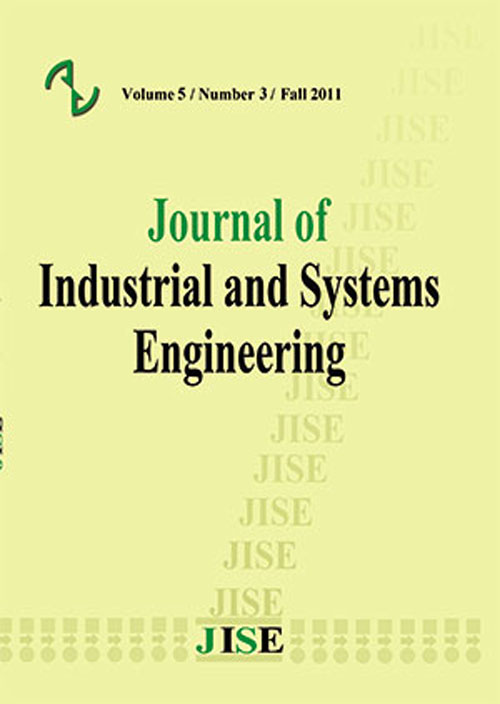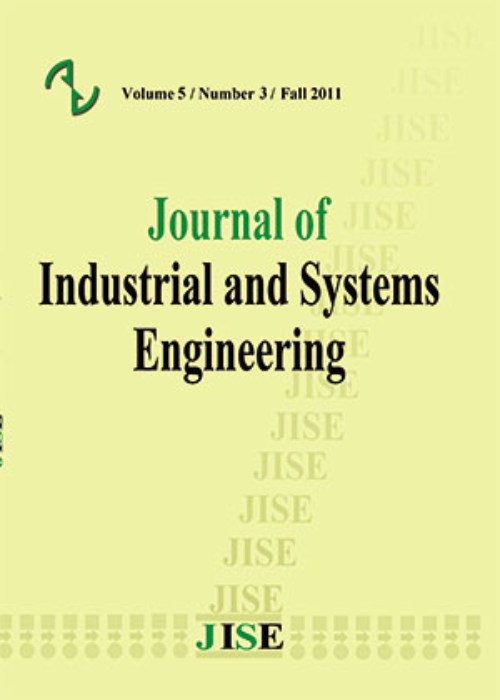فهرست مطالب

Journal of Industrial and Systems Engineering
Volume:14 Issue: 1, Winter 2022
- Special issue: 18th International Industrial Engineering Conference
- تاریخ انتشار: 1400/12/02
- تعداد عناوین: 10
-
-
Pages 1-10In this research, we develop a mathematical model for new generation products in the presence of strategic customers. A firm that produces and sells a two-generation product is considered. It is assumed that potential customers of the first generation are strategic and may delay their purchase to the next generation. The firm aims to determine the optimal price by maximizing total profit. The optimal control theory is used for analyzing the proposed model. The results reveal that strategic behavior influences pricing strategy and reduces optimal price and firm’s profit.Keywords: New generation product, pricing, Strategic Customers, optimal control theory
-
Pages 11-18This study presents an integrated approach for optimizing the location of renewable energy plants. The proposed approach is composed of fuzzy analytic hierarchy process (FAHP) and fuzzy data envelopment analysis (FDEA). The FDEA and FAHP methods are used to select the preferred location. The results of FDEA are validated by DEA, and then it is employed for ranking of location of renewable energy plants and the best α-cut is selected based on the test of Normality. Also, FAHP that is a method based on expert opinion is used for ranking. Five kinds of renewable energies including solar, wind, geothermal, biofuel and hydrogen and fuel cell are considered. The most related criteria are identified from the literature. The intelligent approach of this study is applied to an actual location optimization of renewable energy plants in Iran. In the proposed case study, in some cases FDEA and FAHP select the same alternatives, and for some other cases different alternatives are preferred by these two methods. According to the obtained results, the proposed approach of this study is ideal for renewable energy plant location optimization with possible ambiguity and uncertainty. The aim of this study is helping managers to select optimal locations for renewable energy plants when experts’ opinions are available or not.Keywords: Fuzzy Data Envelopment Analysis (FDEA), Fuzzy Analytic Hierarchy Process (FAHP), location optimization, renewable energy unit, Uncertainty
-
Pages 19-30Nowadays, Telecommunication has a vital role in both developed and emerging economies countries. Especially after coronavirus epidemic, the importance of telecommunication service like internet in education, research, economy and other areas is evident. Due to the alluring market of providing internet services to the main customers of IT industry and its significant profit, the demand of the other services has decreased sharply. Hence, a large part of the revenues of the IT industry be related to internet services. In this study, balancing of revenue sources has investigated as one of the important diagnosis facing the IT industry. In order to overcome this problem, introducing low-demand services along with internet service in the form of a package to the main customers is analyzed with a best-known machine learning algorithm, Generalized Linear Model. In order to validate the applicability of our study, a case study of a company providing telecommunication infrastructure and internet network bandwidth in Iran, is presented.Keywords: IT industry, internet services, Telecommunication, Machine Learning
-
Pages 31-39In this study, first, a brief survey of various portfolio selection problems is presented to explore the related methodologies, hypotheses, and constraints that are considered in these problems. Among these methods, the grey relational analysis approach is employed to deal with poor information and uncertainties in portfolio selection problems. Return, risk, skewness, and kurtosis are used at the same time as selecting criteria in the portfolio construction. To evaluate the effectiveness of the proposed method, an empirical analysis has done. Therefore, fourteen stocks of various industries like metal, banks, financial institutions, car manufactures, transportation, and petroleum from the thirty largest active companies’ index in Tehran Stock Exchange have been randomly selected and all above mention moments have been calculated for each stocks. In this study, the portfolio is restructured dynamically each week based on the ranking of previous week. The result from the analysis indicates that the selected approach has better performance in comparison with the benchmarks in terms of return, standard deviation, and Sharpe ratio.Keywords: Portfolio selection, Grey Relational Analysis, Tehran Stock Exchange
-
Pages 40-47With 17 million annual deaths, cardiovascular diseases are the leading cause of mortality across the world with coronary artery disease (CAD) as the most prevalent one. CAD is the leading cause of death in industrial countries and at the same time is rapidly spreading in the developing world. Thus, the development and introduction of machine learning methods for the accurate diagnosis of heart diseases, especially CAD, have been an important debate in recent years in order to overcome relevant problems. The aim of this paper was to propose a model for enhancing CAD prediction accuracy. It sought a framework for predicting and diagnosing CAD using the features selection of Harris Hawks Optimization algorithm (HHO) and Support Vector Machine (SVM). The heart disease data set of Cleveland hospital available in the University of California Irvine (UCI) was used as the studied data set. It included 303 cases. Each case had 14 features with the final medical status of cases (CAD or normal case) as one of the features where 165 and 138 cases were diagnosed as CAD and normal, respectively. The results of this study revealed that HHO could enhance CAD diagnosis accuracy.Keywords: CORONARY ARTERY DISEASES, Feature selection, Harris Hawk optimization algorithm, Support Vector Machine
-
Pages 48-56Today, Internet-based businesses are one of the most useful tools to make gain in the economies of developing and developed countries. It can even said that the expansion of the World Wide Web caused other businesses to seek customers in the virtual advertising and online world to increase their sales. This study presents a data-driven approach to predict the success of the marketing strategies performance of an online shopping store. The data has been collected by a Poland online shopping website in the year 2008, which has extracted in the UCI datasets. In the data preparation phase, a decision tree (DT) is developed and 13 features of customers are selected for modeling phase. In the proposed method in this research, the rminer package of R software is used. In which three classification models including neural network(NN), support vector machine (SVM), and logistic regression(LR) are developed. Then, two criteria of AUC and ROC curves are used to compare these three models. By comparing the models, it is determined that the NN technique works better than the other three models in prediction. This result can be helpful for marketing managers to plan effectively in website design to attract new visitors and shoppers.Keywords: Classification, Sales forecasting, Machine Learning, clickstream Data, marketing plan, Neural Network
-
Pages 57-63Scientific analysis and providing a way to improve the reliability of high-pressure urban gas networks for sustainable and safe gas supply by suppliers is essential. A reasonable forecast for the achievable flow for each subscriber at the time of failure is the critical network hydraulic reliability in quantitative analysis and is not easy in loop networks. In this article, based on hydraulic indicators and the principles of engineering economics, the degree of reliability and availability of the city gas network has been analyzed. The proposed method relies on the data and findings of the hydraulic analysis and hydraulic regime of node flow in the network and the reliability in different situations with the utilization coefficient of the pressure drop, based on actual flow is analyzed, and provide a solution in determining the cost of the gas supplier company. The results show that the hydraulic reliability of the network has a high impact on the stability of the gas network and for improve of it, the gas companies have to pay attention to design and implementation costs as well as repair and operation costs in network service time.Keywords: Network hydraulic reliability, utilization coefficient of the pressure drop, current value, Structural Reliability, network hydraulic regime
-
Pages 64-73With the ever-growing importance of Customer Experience (CX) in today’s digital marketplace, more and more industries who are in a process of digital transformation have been focused on improving their customer’s brand experience. Focusing on CX has been named as a key factor in maintaining competitive advantage as well as improving customer acquisition and retention rates. Mapping and analyzing customer journeys through their interactions with a business have been identified as one of the most prominent ways to define, evaluate and improve CX. That is why the use of customer journey mapping has been on the rise in recent years, being named as one of the key enablers of successful digital transformation. The use of such methods must take into account differences in various industries and also the cultural context of customers, be it region, buying power, mindset, etc. For the Iranian market, not much work has been done in this area which can provide practical, data driven insights for businesses. In this research, the subject of customer experience and customer journey management in the retail sector, in particular the clothing retailers, has been addressed. To achieve our results, data has been gathered using surveys from customers of the clothing sector, and appropriate analytical methods used to identify main customer touchpoints and analyze the customer journeys.Keywords: Customer experience, customer journey mapping, touchpoints, Digital marketing, digital transformation
-
Pages 74-85This paper studies location-allocation and transportation problem in cross-docking distribution networks that consists of suppliers, cross-docks and plants. A developed mixed-integer nonlinear model is proposed for a post-distribution cross-docking strategy with multi cross-docks and products that cross-docks can be connected. The objective function is to minimize the total cost comprising the cost of established cross-docks and transportation cost. For obtaining this model, at first two models are introduced and compared with each other by solving five short simulated problems (basic nonlinear model 1 and nonlinear model 2 with the possibility of connections between cross-docks). Results indicate that the total cost is decreased when the connection between cross-docks exists. So, model 2 is more efficient and suitable than the basic model. Then, in the following, consolidation of plant orders is added to model 2 and the developed model is formulated. Finally, some problems with different sizes are generated randomly and solved by GAMS software. Computational results show that the developed model is suitable to solve the location-allocation and transportation problem in cross-docking distribution networks.Keywords: cross-docking, location-allocation, Transportation problem, Consolidation
-
Pages 86-90Increasing software as a service (SaaS) requires the provision of more updated models for services, so trying to develop a model customized for the customer is important. We used the linear Knapsack problem model proposed by Mike Hewitt and Emma Frejinger in 2020. Then historical data of Digikala was applied and shown that how the model works on it.Keywords: Optimization modeling, statistical learning, mixed integer linear programming, Third-party Logistics


